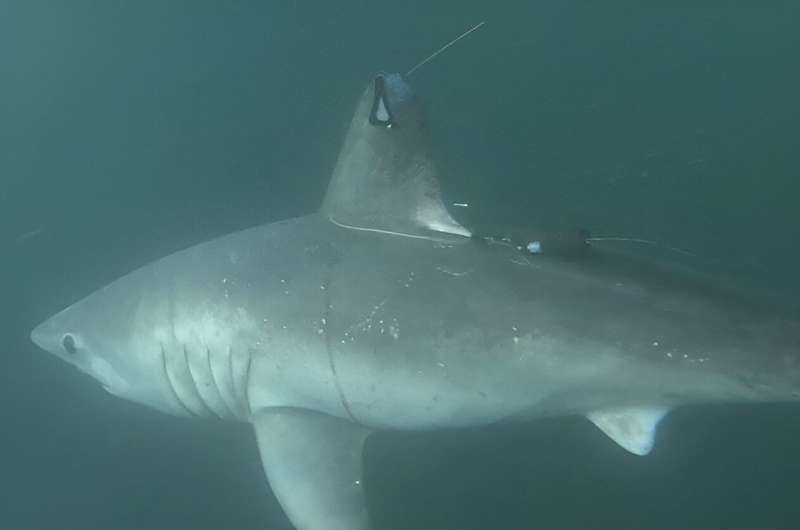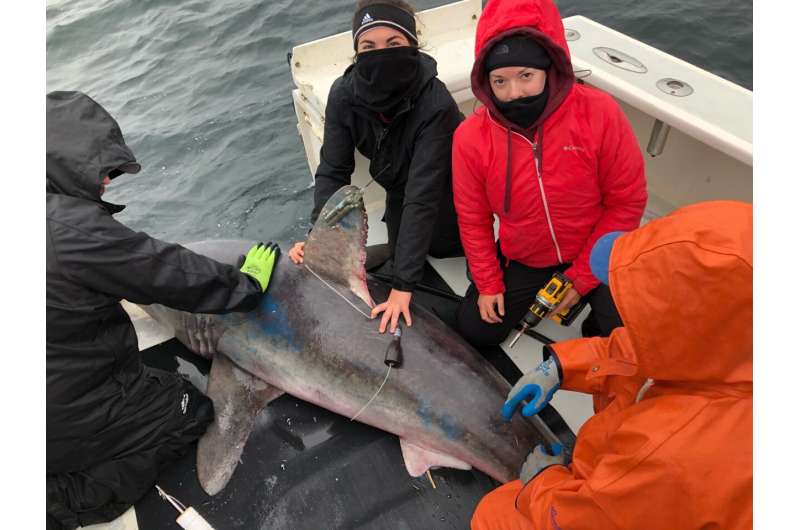
A pregnant porbeagle shark, the subject of the study, after release after tagging. Credit: John Dodd
Who killed the pregnant Prebeagle? In a marine science version of Cluedo, American researchers have now accused a larger shark with triangular baby teeth in the high seas southwest of Bermuda. This scientific whodunnit is published in Frontiers in Marine Science.
“This is the first recorded capture of a porbeagle shark anywhere in the world,” said lead author Dr. Brooke Anderson, a former graduate student at Arizona State University.
In one event, the population not only lost a reproductive material that could have helped the population grow, but also lost all of its developing babies. It is currently suffering from historical overfishing.”
Porbeagles are sharks from the Atlantic, South Pacific and Mediterranean oceans. They are large, active and powerful – up to 3.7 meters long and weighing up to 230 kg – and long-lived, living up to 30 or even 65 years. Females do not breed until they are about 13 years old, and then give birth to an average of four cubs every one or two years, after a gestation period of eight to nine months.
Due to their slow reproductive cycle, porbeagle populations cannot recover quickly from the harassment, recreational fishing, bycatch, and habitat loss and destruction to which they are currently exposed. In fact, Northwest Atlantic porbeagles are listed as Endangered on the IUCN Red List of Threatened Species, while Northeast Atlantic and Mediterranean populations are critically endangered.
The scientific game of tags
In 2020 and 2022, as part of their research on shark migration, Anderson and his colleagues hunted beagles off Cape Cod in Massachusetts. Each Prebeagle was equipped with two satellite tags, a fin satellite transmitter and a pop-off satellite archival tag (PSAT). , before release
Whenever the shark fin rises above the surface, the fin-mounted tags transmit the current location to the satellites. PSATs continuously measure depth and temperature and store this data until the tag is lost, usually after a predetermined period, after which they float to the surface and retrieve the data. They transmit their saved data to satellites.
Among the tagged perebeagles, there was a 2.2m long pregnant female. Anderson and her colleagues hoped to glean data from the material to help identify important habitats for porbeagle mothers and their babies.
But fate intervened. Unexpectedly, the PSAT of this substance began to be transmitted from Bermuda 158 days after its release. This indicates that the PSAT has been destroyed and is now floating on the surface.
The submitted data then showed that this material had been surfing for five months at a depth between 100 and 200 meters at night and between 600 and 800 meters during the day, in waters with temperatures between 6.4 and 23.5 degrees Celsius. During this time, the fin-mount tag was transmitted only once, confirming that she was submerged most of the time.
But suddenly, from March 24, 2021, for four days, the temperature measured by PSAT remained at about 22 degrees Celsius, between 150 and 600 meters deep. Only one explanation was possible: that day, the unfortunate crab had been hunted and eaten by a larger predator. After that, the PSAT should be shed about four days later and begin to transmit.

Researchers tagging a whitetip shark. Center left: Becca Campbell. Center right: Brooke Anderson. Credit: James Solikowski
Two suspects
“Two thermophilic predators large enough to outrun mature porbeagles and located in close proximity when predation occurs include the great white shark Carcharodon carcharias and the mako Isurus oxyrhinchus,” the authors wrote.
Shortfin mako sharks feed on cephalopods, bony fish, small sharks, porpoises, sea turtles and seabirds, while great whites feed on whales, dolphins, seals and rays. Of the two candidates, a great white shark was the more likely culprit, as the short-finned mako typically makes rapid oscillatory dives between the sea surface and greater depths during the day in the open ocean—behavior not recorded by PSAT.
“The hunt for one of our pregnant perbeagles was an unexpected discovery. We often think of large sharks as apex predators. But with technological advances, we are beginning to discover that large predator interactions can be more complex than previously thought,” he said. Anderson
We need to continue to study predator interactions to estimate how often large sharks prey on each other. This helps us understand the cascading effects of these interactions on the ecosystem.”
More information:
First evidence of predation on an adult dogfish tagged pop-off satellite archive in the northwest Atlantic. Frontiers in Marine Science (2024). DOI: 10.3389/fmars.2024.1406973
quote: Large sharks may prey on each other—and scientists know because of the swallowed tracking tag (2024, September 3) Retrieved September 3, 2024 from https://phys.org/news/2024-09-large-sharks-scientists -swallowed is restored. -tracking.html
This document is subject to copyright. Except for any fair dealing for the purpose of private study or research, no part may be reproduced without written permission. Content is provided for informational purposes only.
#Large #sharks #prey #scientists #tracking #tags #swallowed